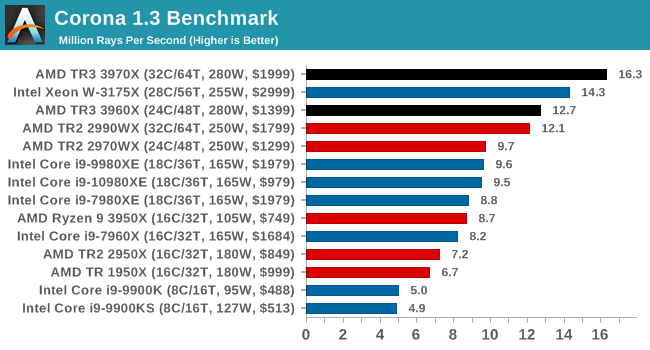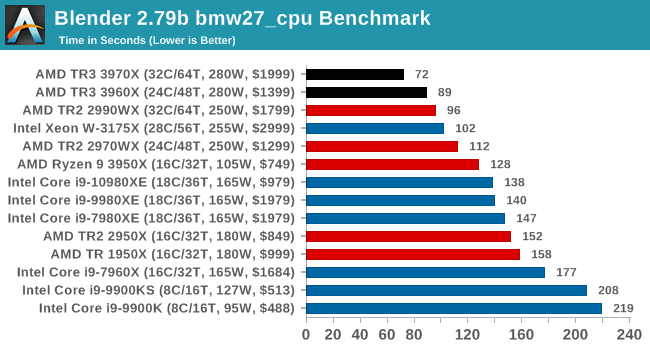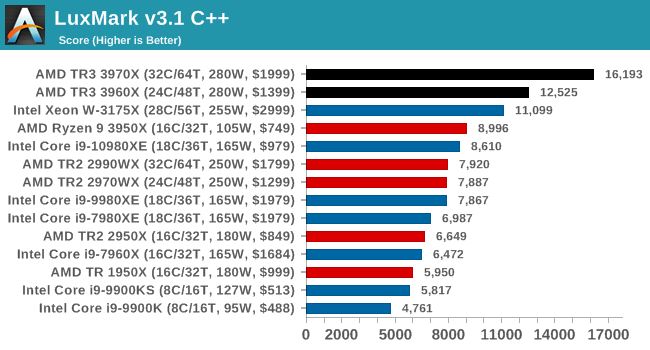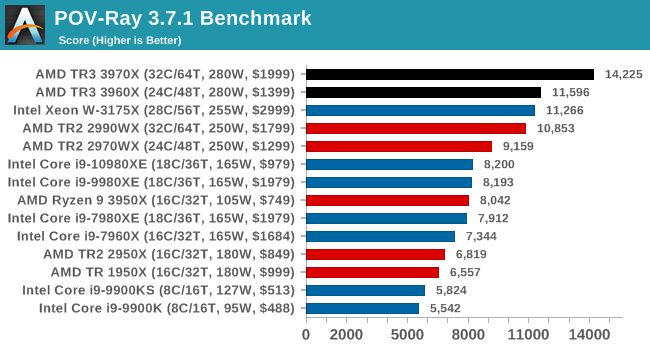The AMD Ryzen Threadripper 3960X and 3970X Review: 24 and 32 Cores on 7nm
by Dr. Ian Cutress, Andrei Frumusanu & Gavin Bonshor on November 25, 2019 9:05 AM ESTCPU Performance: Rendering Tests
Rendering is often a key target for processor workloads, lending itself to a professional environment. It comes in different formats as well, from 3D rendering through rasterization, such as games, or by ray tracing, and invokes the ability of the software to manage meshes, textures, collisions, aliasing, physics (in animations), and discarding unnecessary work. Most renderers offer CPU code paths, while a few use GPUs and select environments use FPGAs or dedicated ASICs. For big studios however, CPUs are still the hardware of choice.
All of our benchmark results can also be found in our benchmark engine, Bench.
Corona 1.3: Performance Render
An advanced performance based renderer for software such as 3ds Max and Cinema 4D, the Corona benchmark renders a generated scene as a standard under its 1.3 software version. Normally the GUI implementation of the benchmark shows the scene being built, and allows the user to upload the result as a ‘time to complete’.
We got in contact with the developer who gave us a command line version of the benchmark that does a direct output of results. Rather than reporting time, we report the average number of rays per second across six runs, as the performance scaling of a result per unit time is typically visually easier to understand.
The Corona benchmark website can be found at https://corona-renderer.com/benchmark

Being fully multithreaded, we see the order here follow core counts. That is except for the 32-core 2990WX sitting behind the 24-core 3960X, which goes to show how much extra performance is in the new TR generation.
Blender 2.79b: 3D Creation Suite
A high profile rendering tool, Blender is open-source allowing for massive amounts of configurability, and is used by a number of high-profile animation studios worldwide. The organization recently released a Blender benchmark package, a couple of weeks after we had narrowed our Blender test for our new suite, however their test can take over an hour. For our results, we run one of the sub-tests in that suite through the command line - a standard ‘bmw27’ scene in CPU only mode, and measure the time to complete the render.
Blender can be downloaded at https://www.blender.org/download/

We have new Threadripper records, with the 3970X almost getting to a minute to compute. Intel's nearest takes almost as long, but does only cost half as much. Again, the 3960X puts the 2990WX in its place.
LuxMark v3.1: LuxRender via Different Code Paths
As stated at the top, there are many different ways to process rendering data: CPU, GPU, Accelerator, and others. On top of that, there are many frameworks and APIs in which to program, depending on how the software will be used. LuxMark, a benchmark developed using the LuxRender engine, offers several different scenes and APIs.
In our test, we run the simple ‘Ball’ scene. This scene starts with a rough render and slowly improves the quality over two minutes, giving a final result in what is essentially an average ‘kilorays per second’.

Our LuxMark test again pushes both TR3 processors out in the lead.
POV-Ray 3.7.1: Ray Tracing
The Persistence of Vision ray tracing engine is another well-known benchmarking tool, which was in a state of relative hibernation until AMD released its Zen processors, to which suddenly both Intel and AMD were submitting code to the main branch of the open source project. For our test, we use the built-in benchmark for all-cores, called from the command line.
POV-Ray can be downloaded from http://www.povray.org/

More rendering, more wins for AMD. More losses for the 2990WX, even though on these tests it still beats the 10980XE quite easily.











245 Comments
View All Comments
Fulljack - Wednesday, November 27, 2019 - link
well, even 64eu gen11 graphics actually couldn't even surpass vega 10 on 3700u.YazX_ - Monday, November 25, 2019 - link
@melgross, LOL cool story, your butthurt is so obvious, being a fanboy is something but living in denial is something else.the only reason one would post such comment is to be an Intel employee, heck, even Intel employees are admitting their defeat.
JKflipflop98 - Wednesday, November 27, 2019 - link
No, we're not.mickrussom - Tuesday, December 3, 2019 - link
If you really are an Intel employee- shame!, shame!, shame! - especially if you had anything to do with:Spectre 1/2, Meltdown 3/3a, Speculative Store Bypass, Foreshadow, L1TF, Fallout/MSBDS, ZombieLoad/MFBDS, RIDL MLPDS/MDSUM
It is utterly criminal what Intel has done. I have zero respect for Intel and it is only by the grace of the US Government Intel is allowed to live. What is happening to Boeing should be happening to Intel for the criminally negligent brain damaged cheating lying trash-chips they have produced with these horrific faults for over a decade. This is far worse than FDIV. And I got a new CPU for FDIV. This is a crime wave and Intel has received a pardon and all of us are left with broken chips that when patch by the OS run half speed or worse.
So to all Intel employees, you better hold your heads down in utter shame until the next wave of CPUs comes out. And support ECC on all the chips - its criminally negligent to hold people hostage with RAM errors.
WaltC - Monday, November 25, 2019 - link
You don't really understand how the quarterly bookkeeping works, I can see. Intel's last quarter was already set in their ordering channels long before AMD's July launch of Epyc Zen 2, R3k, and TR3k is only now launching--it will be all of 2020 that you will see Intel's P&L's grow progressively leaner as you see AMD's grow progressively fatter. Generally it takes 2-3 quarters of progressively worse business before a company's woes begin to show up dramatically on the balance sheet, due to good will and other bookkeeping dodges. Next year will be a Halcyon year for AMD and a critical year for Intel no question about it. Already their roles have reversed, with Intel becoming the "value proposition"--but only provided Intel keeps on cutting its prices. What we've also seen predicted many times in the past is that AMD was *doomed*...;) Not..quite..;)Jimbo Jones - Monday, November 25, 2019 - link
@melgrose"Intel had its best year yet" ... more 10nm delays, so called "14nm shortages", no 10nm for desktop yet, nothing for server yet, same rehashed 14nm with the 10980XE bringing almost no improvement at all per core meanwhile in one generation Threadripper beings up to 32% improvement in multi, 20% in single thread, with no answer from Intel to any of these processors at all and their flagship 18 core HEDT being almost equal to Ryzen desktop in heavy workloads.
But that's ok, let's look ahead to 2020 ... Comet lake aims at add two cores and add 100mhz ... I guess that's pretty good ... for Intel ... ;-)
What IS impressive though, is Intel's ability to keep squeezing money out of gullible people willing to keep paying more money for less product -- I guess that's how they managed to make so much money last year?
mickrussom - Tuesday, December 3, 2019 - link
yeah, how quickly they forget Spectre 1/2, Meltdown 3/3a, Speculative Store Bypass, Foreshadow, L1TF, Fallout/MSBDS, ZombieLoad/MFBDS, RIDL MLPDS/MDSUM. they took our money and unlike Boeing they go no flak from FEDGOV for it. and then they act like arrogant rotten gordon gecko types while laughing to the bank while the CPUs still coming are patch against those flaws mostly in microcode and OS kernels STILL!maxxbot - Tuesday, November 26, 2019 - link
AMD didn't have these sorts of products in the past, trying to extrapolate past performance into the future is a fool's errand. Intel was the process champ for decades and guess what? It all changed overnightTargon - Tuesday, November 26, 2019 - link
Financials vs. products. Intel financials were up because many people were upgrading from older dual or quad core products, and OEMs are barely starting to offer third generation Ryzen based machines. For your typical consumer, not the gamers who can afford a $500 9900k, but your typical consumer, would you suggest Intel or AMD based products at this point? Intel has the 9600, 9700, and 9900 as good products, the rest are beaten by AMD products at the same price point.arcamdomain - Tuesday, December 17, 2019 - link
Nokia said the same thing about the phone market.